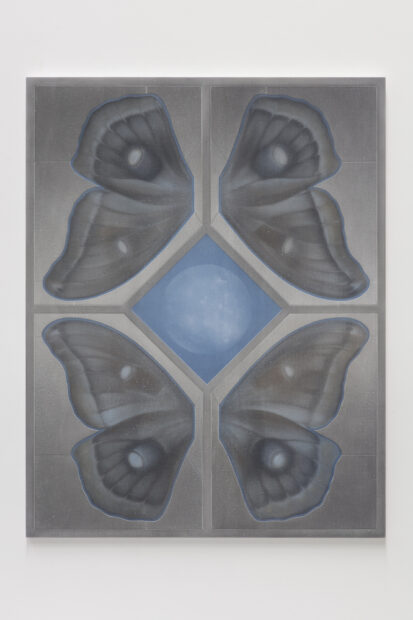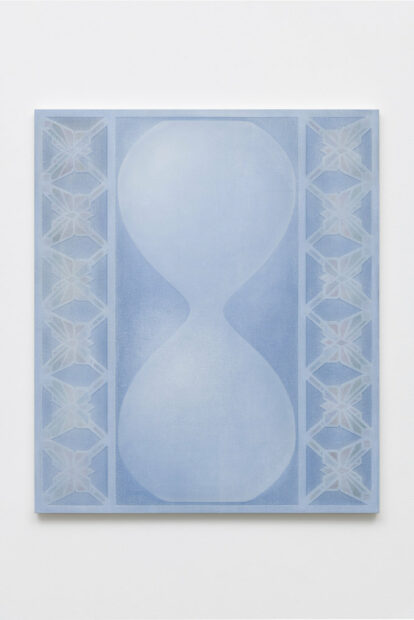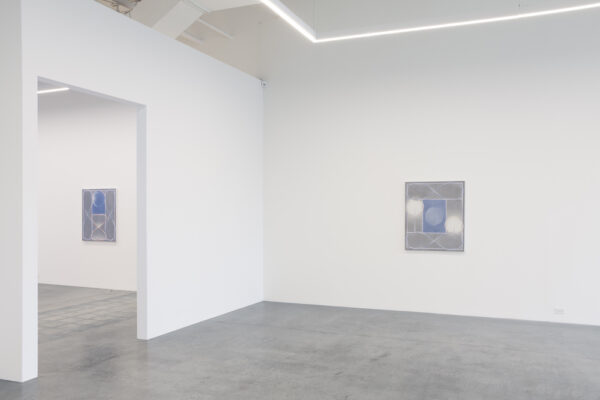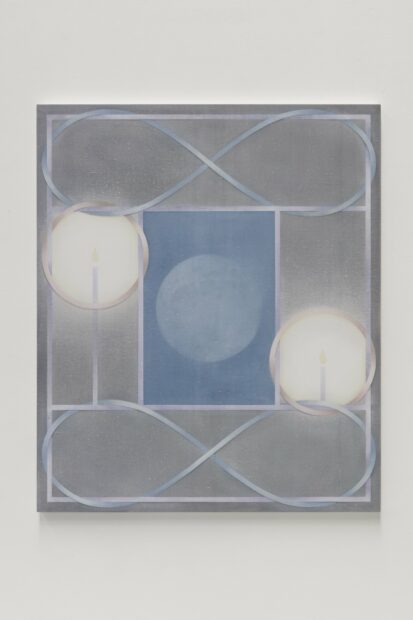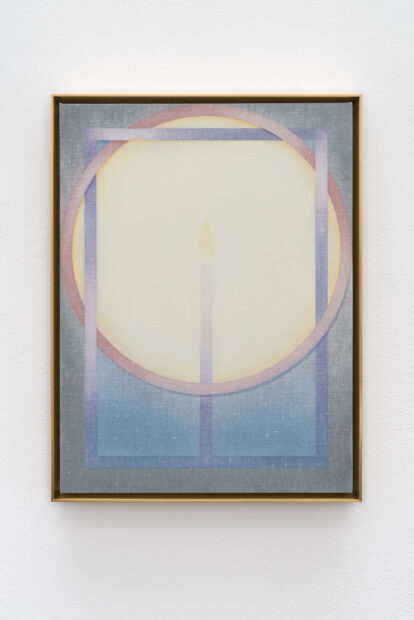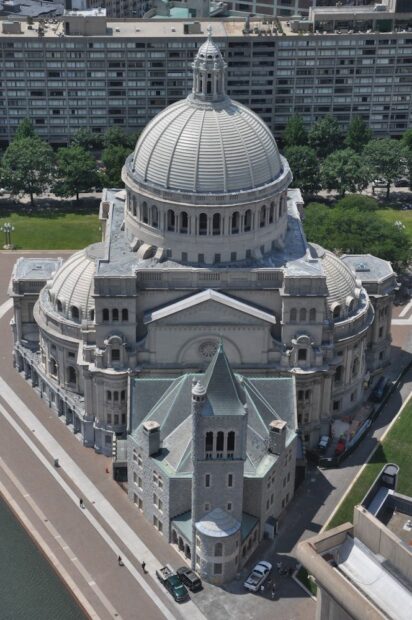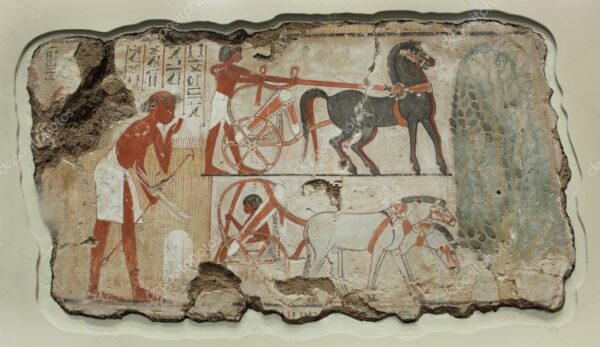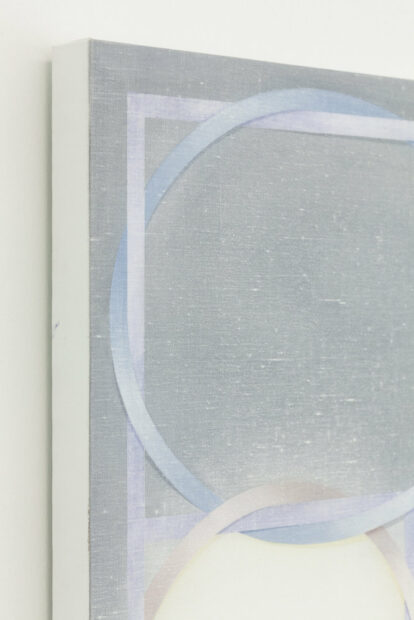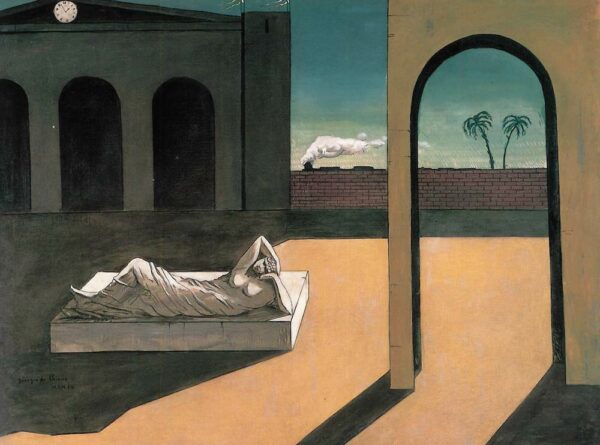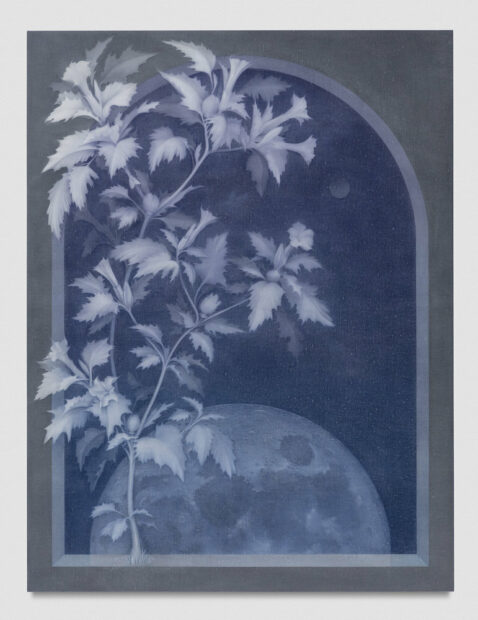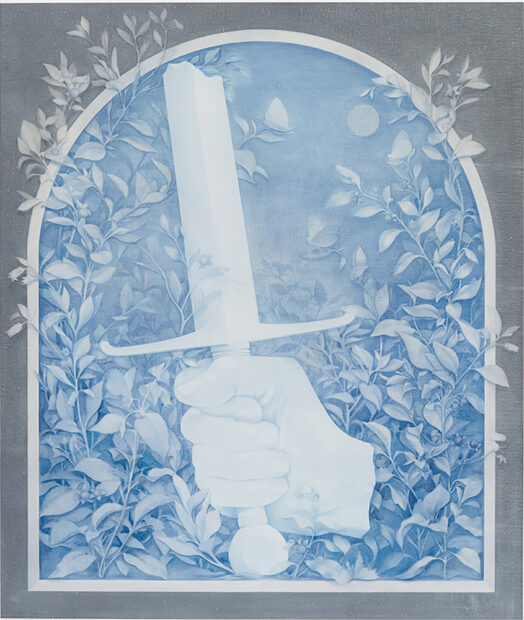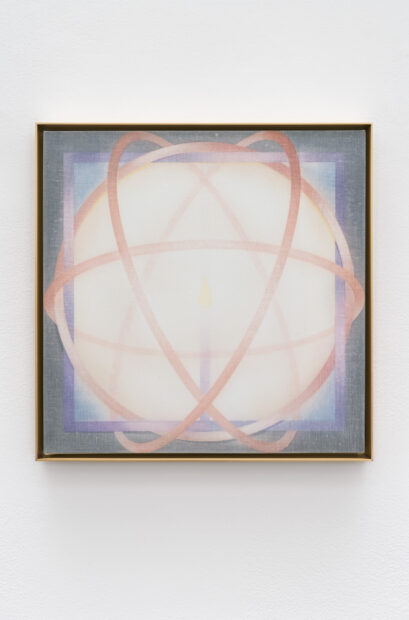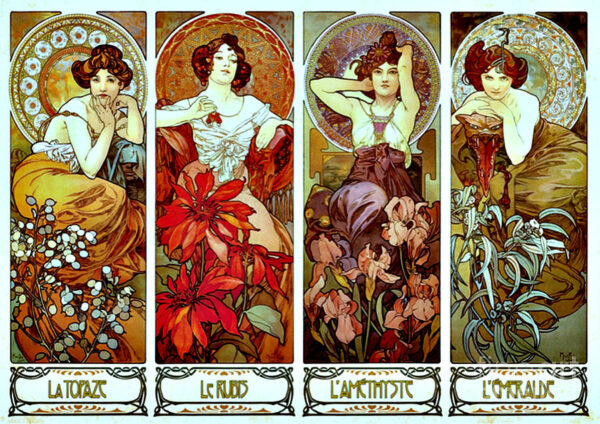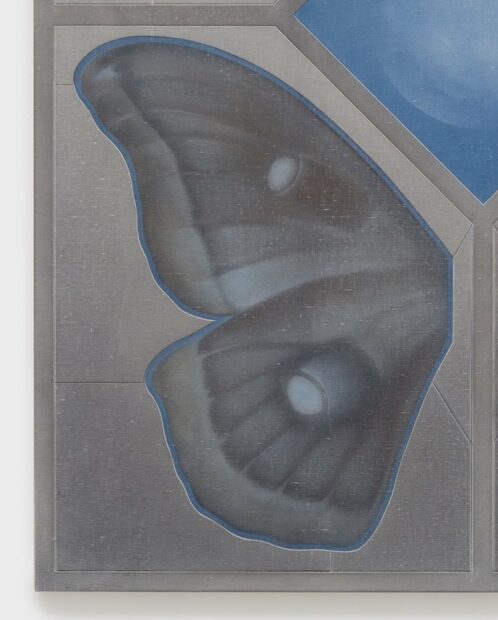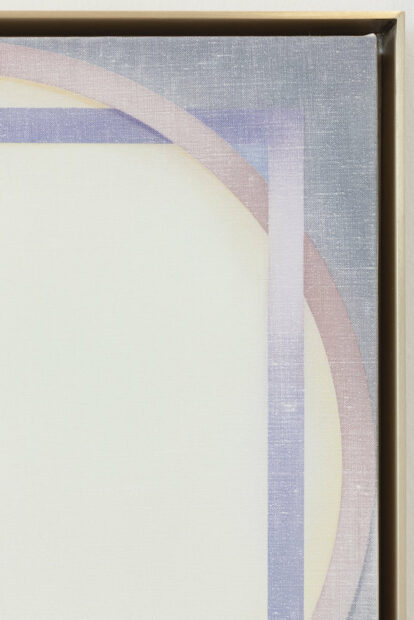The walls of most galleries are white, and Theodora Allen’s paintings marry themselves to the tone.
It’s not that you find patches of plain white peppering the new canvases she’s showing in her Light Pollution show at Dallas’ Gallery 12.26.
Nor is she making white paintings like Malevich, Rauschenberg, or Ryman.
Extreme abstraction ain’t her game: we get pale-toned stuff in her compositions, and in this show it’s moons, hourglasses, and candles (though not a whole lot more…). Besides a love affair with white, Allen gives us a lot of blues and golds — though, if I may be so bold, neither hue’s a heavy- hitter in the ways a color-fanatic like Matisse or Ellsworth Kelly might use ‘em.
She uses color surreptitiously. She uses color (or the lack of it) to nail down a mood.
Color acts as a prompt toward a singular emotional mode, and as color-ing in her canvases.
Sometimes, it’s not a particular thing she’s coloring. Sometimes, she just lays down one single tone (grey, blue, or purple) over most, or all, of the composition.
She bends toward the cool, the meditative, and the mystical.
Matisse said, “Color is expressive.” (And rarely has an artist communicated such a buttload with such brevity.)
Allen’s color expressiveness is singular, but it’s not the primary arrow in her artistic quiver. It’s not the thing she seems to take the most pleasure experimenting with. Allen is creating a spiritual art that leans on tone, symbols, composition, iconic depiction, and a collapsed sense of space.
But the chief horse in this minor calvary of means is composition. She attacks it like a jaunty architect.
Through refined geometry and a debt to classicism, Allen’s work reminds me of Christian Science churches. (Shown here: The First Church of Christ Scientist, Boston, Franklin Welch, Charles Brigham and Solon Beman, architects, 1905.) Her dialogue with tonality is nearly the same. Color interacts with color only a little in Allen’s images, but tone finds its careful equilibrium.
The works are consistently spiritual — they’re pale like ghosts, and speak of the quietude of contemplation. They spring from a deep respect for possibilities unrealized. They sanctify the 12.26 space like altarpieces. And they’re New Agey in the best way.
Theodora (a name that means “gift of the spirit”) is from LA. Her canvases hum along with a familiar kind of SoCal voice, but probably not the one you’re thinking of.
We all know Tinseltown is over-freighted with flash. Movie-makers, sex-tape superstars, and dudes with mugs like Brad Pitt are as common as cornfields in Kansas.
But LA has another tradition. Eastern spirituality landed there early on — with cats like Swamis Vivekananda and Yogananda powering into town a century or more ago. These gurus metastasized a mood that’d already been kicked into life by Franciscan priests with their coastal missions three centuries prior.
Allen’s art has this New Age cast with its fondness for the monochromatic, mystical geometry, and celestial objects. Many of her titles — Cosmic Garden, Infinitude, Dawn, etc. — also draw from a New Age lexicon.
But Allen’s spiritual fellow-travelers can be found in old-time Catholicism, too. LA is architecturally indebted the intrepid friars who built its missions. These 18th-century, stucco-built behemoths dot the state and provide the template for buildings throughout the commonwealth. It’s fair to say: LA is a town of stucco. Usually you see it rendered in a white shade worthy of gallery walls, but it also gets mixed with pigments for mellow color in the mission-style housing stock of Los Angeles.
Paintings made with stucco (in its unadulterated form of plaster) adorn Egypt’s tombs as far back as 5000 years ago. With their matte surfaces and white-plaster base, these compositions have a blanched feel.
They maintain ongoing conversations with white, grey, and low-saturate hues — like the pictures in Allen’s Light Pollution show. Such frescos are found throughout history, but reached a rare apogee of skill via Catholic Church commissions throughout the Italian Renaissance. These 500-year-old compositions adapted themselves to real- life elements in building interiors — windows, wainscotting, etc. — even as they imitate these things with trompe l’oeil in the images themselves.
Allen’s a big fan of the frame within the frame, the arch within the square, and the web of armature that pins down any object that might otherwise laze around without any sense of place.
Plaster in fresco contains lime, and like the gesso undercoating on most paintings, it also carries calcium carbonate and gypsum. Like many painters, Allen paints over a gesso base. Gesso isn’t building stucco, yet it’s a close cousin. Gesso is applied like paint, and sometimes artists use it as just another tincture to white down their colors, but Allen doesn’t mix the gesso white into her pigments in a liquid way.
Surprisingly, Allen creates her low-saturate hues without adding any white at all.
Her method’s much more ethereal.
Consistent with a key theme in her imaginary, Allen builds compositions with semi-opaque washes that patiently occlude the white of the gesso — thin coat, after thin coat, after thin coat.
This is where the exhibit’s title, Light Pollution, comes from, as Allen reports. She talks about “polluting” the light that the gesso reflects — laying down thin layers of barely opaque linseed-based paints, veil by veil. She clouds the white of the gesso away — sort of like smog swims across the LA sky, partly blotting its luminescence from view.
But, even smoggy days in LA are usually bright, and Allen doesn’t want to completely pollute the gesso’s glare. She stays at play with the white ground, utilizing it in her depiction strategies like a good watercolorist. She scrapes back her already-applied paint layers, too, making the gesso (and the warp and woof of the linen behind it) emerge from underneath any given color-field.
When you move in close to the canvas, you notice this asterism of hoary lines and pallid dots. Areas of flat color shimmer like night skies. Close views reveal a constellation of stars.
In fresco painting, plaster dries through a crystallization process, so it reflects light in a lively way — even if it doesn’t quite create constellations as Allen’s strategy does. Be that as it may, her approach shares an immense amount with Renaissance fresco masters — particularly that master of quietude, Fra Angelico.
Here, we see his 1445 Annunciation. It depicts a moment in the Bible’s Book of Luke where Gabriel tells Mary she’s pregnant with the “Son of the Most High.”
Allen’s interplay with religious silence, white, and architecture finds its throughline in the work of a second, modern Italian Catholic, the self-styled “metaphysical” painter, Georgio de Chirico, whose Soothsayer’s Recompense (1913) is found here. Unlike Allen, De Chirico loved him some hot color palettes. He loved the play of space, too, achieving expansiveness, but with very blunt means. He seems to set 2-D stage-flats one behind the other.
His predecessor, Fra Angelico, sought depth of field like his Renaissance colleagues, establishing three-dimensionality that operated like a “come hither” message — not unlike a good marketer who puts windows all over a shop’s storefront.
Unlike De Chirico or Angelico, Allen radically collapses her space. In these spare prosceniums, any “come hither” message is whispered. This disposition fits this year’s epidemiological anxieties. It says to viewers, “We can mingle, but please keep social distance.”
Her space-crafting (to create a phrase) carves out “reliquary-like spaces” — to quote her online biography.
Consistent with this, her compositional elements are often rendered in a flattened, graphic way. Her spatial strategies don’t call to mind fellow picture-makers so much as they do the 3-D collage boxes of the Christian Scientist, Joseph Cornell. In her narrow stages, Allen’s pictorial elements operate like Cornell’s collage elements, but unlike Cornell, or de Chirico’s surrealism, she never tilts toward the humorous or absurd. Like the engravings on tombstones, her jumbled images speak of distillation, departure, and the deadly sobriety of time.
In her larger oeuvre, plants dance with swords, hourglasses loiter near moths, and monumental screws stand as gray sentries among blossoms of jimson weed. In Cosmic Garden, this weed is rendered in a kind of purple sepia. It dances before an archway as the moon pokes over the arch’s parapet. Though included in this exhibit, this painting comes from a previous show where plants took a prominent role. A 2019 article by the arts writer A. G. Wollen quotes Allen as saying that all her flora are “narcotics, or destabilizers, or medicinal.” They’re “survivalist plants. They thrive in poor soil, they don’t need a lot of water.”
With all the conviviality of a county-seat mortician, she consistently knocks on the doors of otherworldliness, sleep, and desiccation. Her objects speak of spare living and altered states — realms of the deceased, of the religious mystic, and the ascetic.
She spoke about her work with clarity at the 12.26 opening. She said her use of encircling lines and plant- life harkens back to Art Nouveau — but I see Art Deco in it, too. Bars, lines, and a range of armatures entrap her various sources of energy and life — moths, candles, and plants. In an action that’s highly heathen for an Angeleno, she even attempts to bind the sun.
In the annals of Art Nouveau, Alphonse Mucha was probably its greatest purveyor. Like De Chirico, he inclines toward a warmer color palette than Allen, but, aside from that, if these artists put their genes together, they’d birth Theodora Allen.
She leans on De Chirico’s silence and Mucha’s entwining lines, but whereas Mucha is clearly a voluptuary, giving us lusty pics of curly-headed gals, twining plants, and heaped-up colorful cloth — delighting in the play of movement and life — Allen tacks towards low- saturate CliffsNotes on stasis and the surety of mortality.
Not to lean on Matisse too much for this review, but the leader of the “Wild Beasts” art school also said:
“What I dream of is an art of balance, of purity and serenity . . . something like a good armchair which provides relaxation from physical fatigue.”
Paradoxically, Matisse did this by surrendering to riotous color, but Allen gives us this same “relaxation from fatigue” by delimiting color and strapping everything down in that seat as if it were a half-dusted, star- spangled electric chair.
Allen’s a builder of quiet, comfortable jails.
Sometimes, she constructs these tight spaces with a strategy of “mitering,” to borrow a woodworking term. She likes to take a thing and saw it down to size, strait-jacketing it into the picture plane.
We see this action with the moths in From the Watchtower, the sun in Dawn, and the infinity symbols in Infinitude No. 1. Again, if you get your nose right up to the canvas, you see that she slams things right up to the line of the linen as it wraps over the stretcher- bar beneath. It’s as if she’s pressing into the liminal — taking the material to the edge of the immaterial.
At a concrete level, she’s showing she can play at meeting other worlds — that she can play at the psychological state-change, and the action of bringing the inner to the outer.
Even as she motors dangerously away from her tonally-controlled realm toward the wild white of the gallery space, she keeps the container-ship of her canvas all battened down by setting pictorial elements into place like corpses pressed safely into coffins.
Even when she sticks a sword in a painting, it’s hewed off, neutered, held for show, not to strike.
This strategy engages with another artistic cousin — the last one I’ll introduce in this long meditation on this artist’s little aviaries.
If we look at the soundless, tonal-focused paintings of Vija Celmins, we see that Allen imitates her attitude. Both give us quiet worlds in slim tonal ranges, and try to hold back seconds of time that might flitter away.
Celmins takes her fields of stars, or rocks, or cloud-sky right up to the picture-frame edge — sort of like the color-field painters birthed by Malevich. Like Allen, Celmins pushes actual pictorial elements to the edge, even if they may operate as non-referential fields of pattern or color.
Both use weapons of war in their imagery — planes in Celmin’s case. Akin to Allen, she’ll trap them in their photo-click moment, sealing them off with masterful pencil, print, or paintwork in soft white, black, and grey.
Celmins has said, “My work lies between intimacy and distance.”
The comment suggests she’s keeping life at arm’s-length.
If we had to inscribe some note on stone to memorialize Allen, this phrase would be the right fit for her epitaph.
Through October 24 at Gallery 12.26 in Dallas


